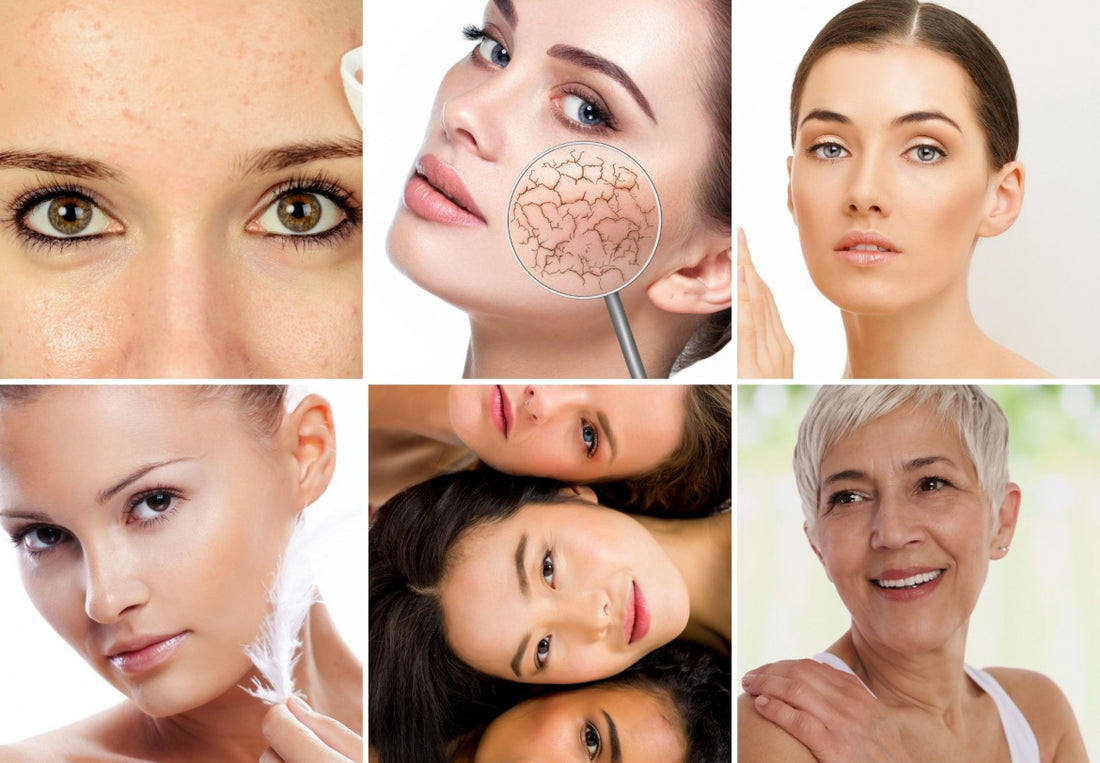The skin is a fundamental part of our body , it distinguishes us as individuals and protects us from external agents. It can vary over the years, influenced by habits, age and weather conditions: wind, sudden changes in temperature, variations in humidity and UV rays visibly change the appearance of the skin.
Each biotype has unique characteristics that require suitable cosmetic products. Let's find out the characteristics of each one.
OILY ACNE-PRONE SKIN

CHARACTERISTICS
• To the eye, it appears shiny, oily, dehydrated
• May have blackheads or whiteheads
• Dull complexion
• To the touch, the texture is irregular and rough
• Often has dilated pores and tends towards redness
• It is more susceptible to acneic forms, seborrheic dermatitis, dandruff and androgenic alopecia
TREATMENTS
Gentle cleansing reduces the risk of further increasing sebum production.
It is essential to choose products that can balance the activity of the sebaceous glands.
An ideal cosmetic for oily skin must purify and hydrate the superficial epidermal layers, fight bacterial proliferation and promote the closure of the follicles.
Used in moderation, exfoliants stimulate cell renewal.
DRY SKIN

CHARACTERISTICS
• To the touch, it appears rough, not very elastic, cracked and with an irregular texture
• To the eye, it is fragile, thin, flaky
• Light and dull complexion
• Manifests premature skin aging phenomena, especially wrinkles
• The hydrolipidic content of the stratum corneum is significantly lower than the physiological values
TREATMENTS
Dry skin requires an intensive cosmetic treatment aimed at hydrating the most superficial epidermal layers and deeply nourishing the skin with nourishing substances.
Products suitable for this skin type:
• Humectants and gelling agents (eg glycerin, mucilage, hyaluronic acid, silk proteins, collagen)
• Emollient cosmetics (e.g. vegetable oils and butters, ceramides, polyunsaturated fatty acids)
• Film-forming substances (eg vaseline oil)
• Bee products such as honey and beeswax.
NORMAL SKIN

CHARACTERISTICS
• To the eye, it has a light and rosy colour.
• To the touch, it is smooth and smooth
• From a physiological point of view it has excellent microcirculation, a right degree of hydration and a balanced hydrolipidic film
• Bright, transparent and flawless
TREATMENTS
Beauty products designed for normal skin aim to maintain its characteristics.
The advice is to prefer maintenance products, therefore sunscreens and moisturizers.
MIXED SKIN

CHARACTERISTICS
• Combination skin has similar characteristics to oily and dry skin simultaneously: in some areas, combination skin appears oily and acne-prone, while in others it is extremely dry and flaky
• The most critical points of this skin type are the nose and forehead, which tend to have blackheads and enlarged pores
TREATMENTS
The treatment for combination skin is extremely complex: it is essential to avoid further drying out areas of dry skin, and weighing down areas that are too oily.
Moisturizing and sebum normalizing cosmetics are the most recommended.
SENSITIVE SKIN

CHARACTERISTICS
• Fragile skin, predisposed to react negatively to irritating physical or chemical agents
• To the eye, it appears thin, scaly and easily irritated
• To the touch, it is often hot, sometimes dry
• Subject to the early formation of wrinkles and other skin blemishes
• The skin barrier function, often heavily impaired, makes this type of skin highly susceptible to external aggressions
TREATMENTS
The cosmetic treatment to improve the appearance of this skin type must be extremely delicate.
Delicate, moisturizing, emollient cosmetics free of dyes, nickel, cobalt and chromium should be preferred, to avoid unpleasant sensations of skin stretching, flaking, dryness and redness.
It is advisable to avoid excessive and prolonged exposure to the sun and to always protect the skin with a high level of protection.
MATURE SKIN

CHARACTERISTICS
• Visually, it has spots, marked wrinkles, dark circles and pronounced bags.
• The dermis becomes thinner, while the skin becomes less turgid
• The skin is much more sensitive to mechanical trauma
• It is not very elastic to the touch, rather wrinkled and very relaxed
• Extremely susceptible to the effects of solar radiation
TREATMENTS
Cosmetic products for mature skin generally contain these substances:
• Moisturizers and anti-wrinkles (eg hyaluronic acid creams)
• Antioxidants (vitamins A, C and E, polyphenols)
• Depigmenting, able to inhibit the production of melanin (eg alpha-hydroxyacids)
• Exfoliants and cell turn-over accelerators (glycolic acid creams)
• Sunscreens (containing chemical or physical filters that screen from UVA and UVB rays)
Mature skins require more specific cosmetic treatments also for the lip and eye contour.
BABY SKIN

CHARACTERISTICS
Children's skin is extremely delicate and differs from that of adults in the following characteristics:
• Thinner dermis and epidermis
• Reduced melanin content
• Poorly developed hydrolipidic film
• Poor immunity against bacteria and fungi
• slightly higher pH
• Marked tendency to diaper rash
TREATMENTS
Cosmetics that focus on baby products focus on delicate detergents, talcum powders, deeply nourishing and moisturizing creams, and sunscreens.
It is recommended to pay particular attention to cleansing the baby's genital areas, which are very delicate due to typical diaper rash.
It is also necessary to always apply a generous layer of sunscreen to the child's skin before sun exposure, which must in any case be moderate.

